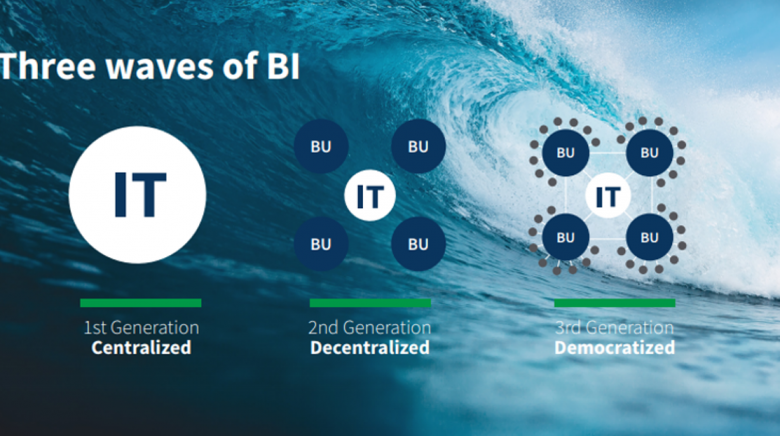Whitepaper: 3rd-Generation Business Intelligence
Discover how the 3rd generation of BI spreads analytics to every corner of your business, finally giving all your users the power to make discoveries that ignite transformation.


The business intelligence (BI) and analytics landscape has and is continuing to evolve rapidly in Australia. We’re now heading into what’s termed as 3rd Generation BI to help businesses better harness the potential within their data for competitive edge. Qlik is at the forefront of this new approach that revolves around a crucial principle, the democratisation of analytics. Here we’ll explore how BI has evolved and what makes Qlik’s 3rd Generation BI platform and approach unique.
Data has always held tremendous value, but for decades, most of that value has remained inaccessible due to technical limits and complexities. The centralised approach of the 1st generation of BI, known as ‘The Ask/Wait/Answer Cycle’, was based on a centralised approach to BI, usually too reliant on a few people within IT that possessed the necessary technical skills, often overworked and under resourced, and therefore slowed down and diluted the full potential of value from analytics.
With the 2nd-generation of BI, a user-friendly, more decentralised approach to data emerged and eliminated technical complexities and enabled users to freely explore and discover connections within their data. This data discovery approach to BI emphasised data visualisation, self-serve analysis and transformed how users engage with data. But as the technology gained the capacity to analyse more types of data, the need to develop a secure and governed structure to deliver accurate data and reliable analysis also grew.
What has remained steady throughout an era of rapid technological development is Qlik’s pioneering and innovating ethos. The decentralised approach of 2nd generation BI has been the stepping stone to the development of a new wave of BI- the 3rd generation. Nonetheless, data literacy has persistently remained an obstacle as insight without action cannot lead to value. As of 2017-2018, only 24% of business users considered themselves to be data-literate in a study conducted by Qlik.
The need for data literacy is crucial, Gartner talk about this in their latest 2019 Analytics & Business Intelligence Magic Quadrant Report, as data is the currency of the digital economy. The ability to extrapolate intelligence and anticipate customer needs to fully capitalise on discoveries requires available data to be accessible and actionable throughout the entirety of your organisation, in turn transforming how a business operates.
The 3rd Generation approach to BI is about bridging this data literacy gap, still enabling users to freely explore data to garner insights in the way they need to but with structure and data governance in place. This is about democritising analytics. Qlik is one of the BI platforms pioneering this innovative BI approach.
The answer is in the interaction of three innovative technologies as the foundation of Qlik’s 3rd generation BI approach, which also encourages more widespread adoption of analytics across the organisation.
All data and any combination of data is accessible to all users through governed, analysis-ready, enterprise-wide information catalogues. Qlik’s approach enables the creation of an enterprise-wide data schema that fully integrates all your data, from any source, regardless of how big it is or where it’s stored.
Qlik combines the power of machine learning with human intuition, highlighting new insights and accelerating discoveries for users to explore whilst also increasing data literacy and trust. This combination of Associative Index with Augmented Intelligence (AI2) simplifies advanced analytics, eliminates bottlenecks, and elevates data literacy and insights. Like the unique Associative Indexing technology, Augmented Intelligence combines human interactions with machine identified patterns. The Associative Technology maps associations among all the data, preparing it for analysis and creating meta-data and indexes that represent the data.
Qlik’s open and extensible platform allows analytics to be deployed or embedded in a range of environments from enterprise servers to public cloud infrastructure to edge devices and IoT applications. This means analytics enters the streams of daily business processes from edge devices all the way to your core applications within the business.
Combined, Qlik’s approach helps businesses extract the most value possible from their data for competitive advantage, making it easier to prompt and discover insights and trends within the data, regardless of the level of technical skill of the user. Qlik has managed to strip out the complexity, technical limits, resource bottlenecks and skills gaps that have previously kept analytics out of the hands of business users. A radically different approach that will help achieve data driven digital transformation and competitive advantage for businesses.
To find out more read the full report in this whitepaper, “3rd-Generation BI: Unlocking All the Possibility in Your Data”, to discover Qlik’s innovative approach to BI.
Please refine your search criteria and search again